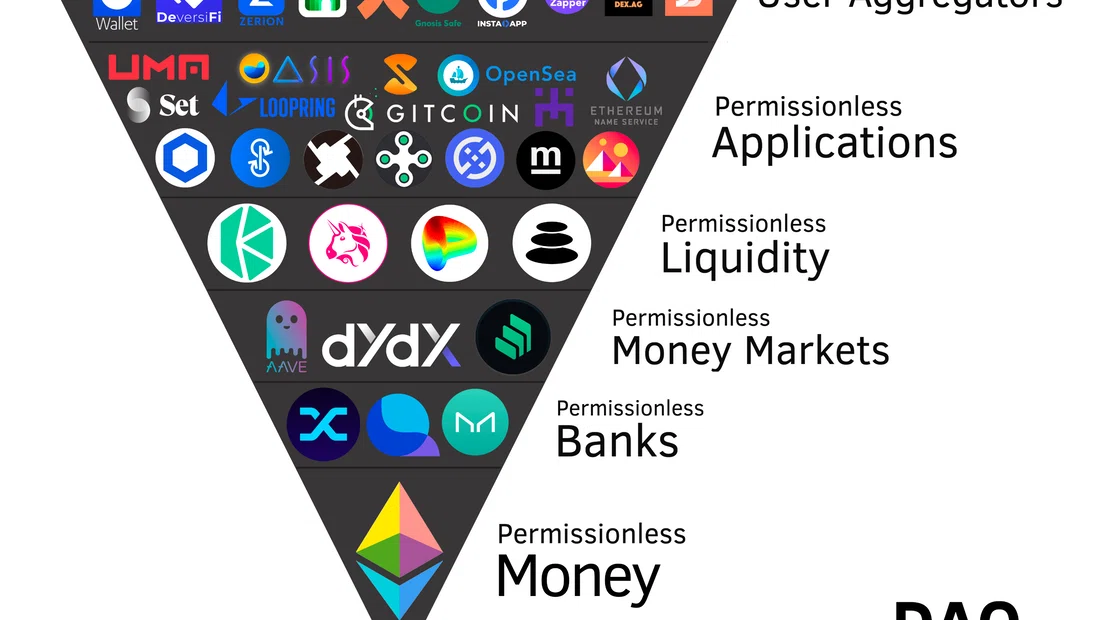I recently did a Linkedin poll and no surprises that Ethereum (Eth) remains the most popular blockchain with ~70% of 3,600+ respondents voting for it.
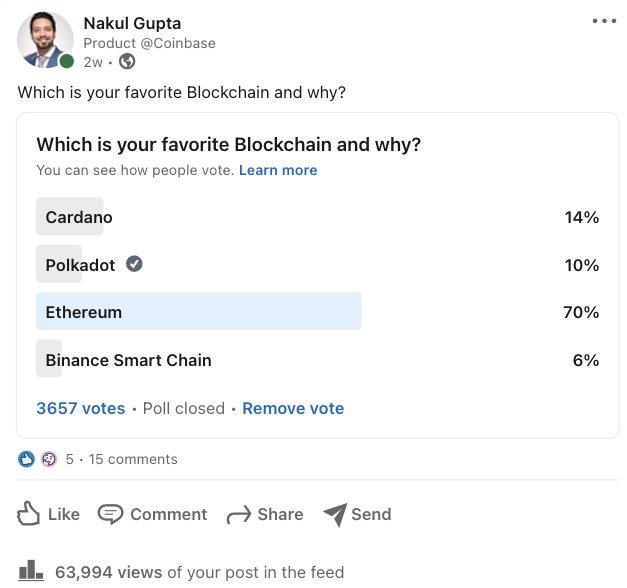
With the upcoming upgrades, Eth is evolving to be the ultimate triple point asset - as a capital asset, a store of value and a consumable asset (more on that later). I have invested more than half of my crypto portfolio in Eth, which also represents a sizeable share of overall investments. Mark Cuban said on a recent episode of The Delphi Podcast that his portfolio allocation is broken down as: “60% bitcoin, 30% Ethereum and 10% the rest”. Why is everyone so bullish on Ethereum?
Let’s take a simple analogy, comparing PayPal and Ethereum as money transfer networks. It is really interesting to note that Eth moves more payment volume, is leaner with resources, growing faster and has not even unlocked its full potential yet.
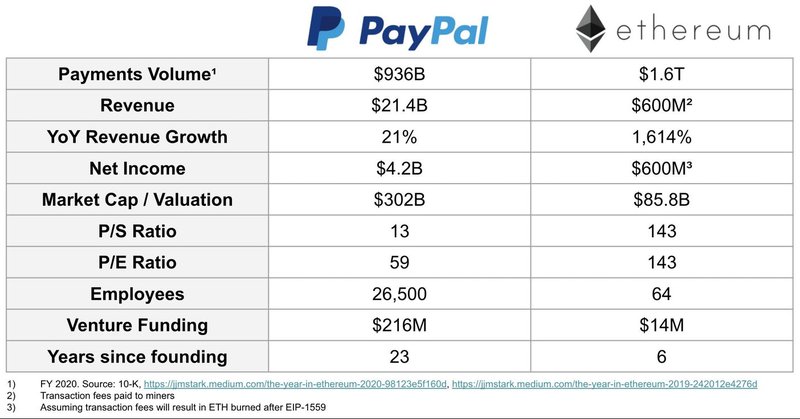
The main thesis why Eth has been called ‘ultrasound money’ and might be the most investable asset class right now is based on the following arguments:
- If you believe in Blockchain and its evolution to be as revolutionary as internet, then Ethereum will emerge as the underlying code infrastructure
- Smart contract functionality of Eth (due to turing completeness and composability) makes Eth the “Excel of Blockchains”
- Eth is emerging as a ‘world computer’: the backbone of a decentralized internet and the settlement layer for web 3.0
- Eth adoption has already gone mainstream: there are strong long-term demand drivers and network effects in place
- Ethereum holders will start making a lot of money: EIP 1559 together with ETH2 improve performance while dramatically altering where value accrues in the Ethereum ecosystem (lower supply + deflationary)
- Eth may emerge as world’s most efficient triple-point asset simultaneously serving as ‘Store of Value’, ‘Consumable Asset’ & ‘Capital Asset’; making it ultra-sound money
- ETH will be the dominant Layer 1, despite challengers (Solana, Cardano, Flow etc.) as most will be complementary to Eth ecosystem
1. Ethereum will emerge as the underlying code infrastructure for blockchain
“The most bullish thing for Ether is to be understood.”
What if I told you about a business with strong network effects and 200x YoY revenue growth that was preparing to offer a 25% dividend and implement a permanent share buyback program? Is that something you might be interested in?
That’s pretty much Ethereum. It’s one of the most fascinating and compelling assets in the world, but its story is obfuscated by complexity and the specter of crypto.1
Launched in 2015, Ethereum is a decentralized blockchain like Bitcoin, but is far more programmable, meaning other applications and currencies can be built on top of it. Its native cryptocurrency is Ether, which today stands as the second most valuable cryptocurrency after Bitcoin. Perhaps even more interesting, transaction fees on the Ethereum network have recently approached $15 million per day, meaning there's a real and growing demand to use the Ethereum network.
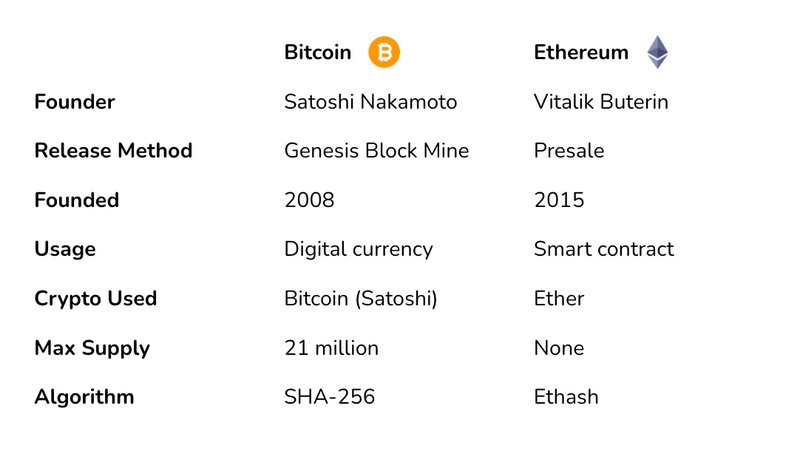
Historically, we've seen all sorts of things, like one simple non-financial application, is called ENS, the Ethereum name system, the equivalent of DNS but on a different network. The idea is that it's just a name registry service and it maps human-readable names. For example, Justin.eth to a machine-readable address, which is a long string of numbers and digits. This will be the equivalent of translating, let's say, google.com to an IP address. The beauty of doing it on Ethereum is that you remove the very messy infrastructure of registrars, ICANN, and DNS, whatever the root nodes and whatnot. Basically, you collapse all this messy trust infrastructure into just code, and you just need to read the code. It's very few lines of code, and that's this registry, which is the mapping from human-readable names to machine-readable addresses. Now, that was one of the early use cases. What we're starting to see right now in terms of real traction is really in the financial space. We call this space generally decentralized finance or DeFi. But now we're kind of basically expanding the layers of complexity of DeFi. Now, we're starting to see all sorts of crazy things happening on DeFi. We have lending platforms, like Maker and Aave. We have prediction markets. We have insurance markets. All of these are basically what we call money legos. They're pieces of infrastructure, which are credibly neutral, and trustless, and the public good. Even though they have a well-defined creator, that creator has no unfair advantage over this piece of infrastructure. You have these money legos and they have a superpower, which is that they are compostable. We're starting to see organically these somewhat complex economic structures forming just by mushing together and mixing and matching these various money legos. Right now, we're in a period of extreme experimentation, which is very thrilling and exciting.2
How Blockchain is similar to Internet in early days

the evolution of two open networks (the internet and digital currency). Source: Coinbase blog
Because it’s Ethereum’s native asset, ETH has a privileged position inside Ethereum’s economy.3
- It is the only asset on Ethereum that wasn’t issued by a smart-contract, and therefore has no smart-contract risk.
- It’s native to the Ethereum protocol, so it has no counter-party risk.
- It has assurances towards its scarcity, because any monetary policy failure is a risk to the Ethereum network, not just the DeFi apps on top of it (aka, we’ll have bigger things to worry about).
ETH is the most trustless asset on Ethereum because every asset other than ETH has some compromise to its trustlessness. Without ETH, DeFi apps would be forced to capture value in tokens that have centralization risk dependencies - Bankless
2. Smart contract functionality makes Ethereum the ‘Excel of Blockchains’
Blockchain is essentially a coordination platform for people on the Internet, who don't necessarily trust each other or know each other. It's kind of extending the superpowers of the Internet. The Internet, in its first stage, gives us incredible communication powers with real-time video and whatnot. Now, we're extending this to the ability to be this trust platform for people who don't trust each other. It's a way to build ties, and that's very powerful because trust is everywhere in our society. The way that trust is mediated today is largely through companies, corporations, institutions and, to large extent, mediated through legal contracts. Here, we have an opportunity to have programmatic trust, if you will, or trust that is native to the Internet, which does not involve so much human intervention. It's more trust in the code, trust in the mathematics, trust in the technology. And this really opens up all sorts of exciting innovations as per John Colossus, a researcher at the Ethereum Foundation
Ethereum is a Turing complete, programmable blockchain that lets anyone build full-blown applications using smart contracts. People can build all sorts of decentralized apps (dApps) on top of Ethereum, plugging into the blockchain and the surrounding ecosystem to provide everything from security to identity to payments. Decentralized Finance (DeFi) apps, NFT marketplaces, Decentralized Autonomous Organizations (DAOs), and games and virtual worlds can all be built on top of Ethereum, all fueled by the native currency, ETH.
If there is a core product design lesson to learn from Excel, it’s that combining usability with flexibility is both incredibly difficult and incredibly rewarding….
A design principle for developers is to make any one piece of software really good at one specific thing, deliberately constraining its capabilities to a specific domain. Excel is a truly remarkable exception to this rule - it is something of a choose-a-phone, and clearly hundreds of millions of people do want to compose for it.
You could replace “Excel” with “Ethereum” and it works perfectly - Packy McCormick from Not Boring
- Turing Completeness. If something is Turing complete, it means that it can solve any reasonable computational problem. With the introduction of Lambda, which lets users create their own formulas, Excel became Turing complete. With Ethereum, you can write smart contracts that can solve any reasonable problem.
- Composability. In Excel, “You can chain functions, passing the output of one function as the input to another, allowing for an enormous number of potential computational pipelines. Each time Excel adds a function, the power and flexibility of Excel is multiplied, since that new function can be chained to a large number of existing functions.” This is very similar to the idea of composability, or “X Legos,” on Ethereum.
Together, Turing completeness and composability mean that you can build smart contracts to compute anything, and then chain them together to build increasingly complex things, more quickly. It takes time to get the engine revving, but it should move quickly once it’s moving.
The smart contract technology has made it possible for artists, meme-makers, and musicians to sell their virtual wares is also fueling a new, decentralized alternative to the current financial system. In that alternative system, which is designed to economically empower individuals, capital will flow through open-source protocols that are faster, cheaper, more transparent, and available to all.
NFTs are mostly issued on the Ethereum blockchain — taking advantage of its “smart contract” functionality — and can generally be bought or sold on marketplaces dedicated to them. (While they’re getting huge buzz now, NFTs aren’t actually brand-new. You might recall the 2017 craze around Cryptokitties, a digital-cat-trading game.)
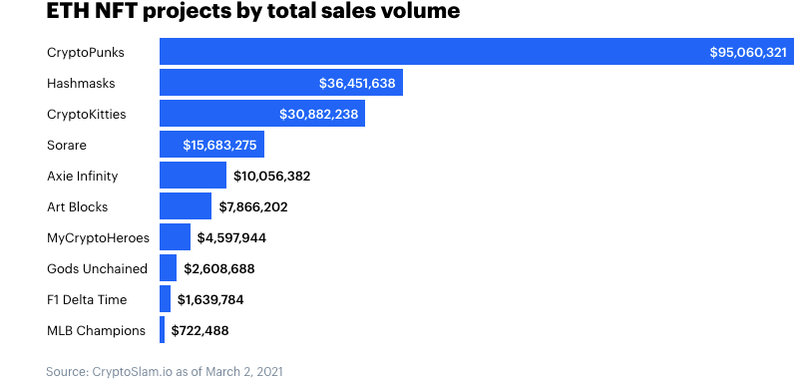
3. Eth is emerging as a ‘world computer’ and the backbone of a decentralized internet (web3)
Ethereum is so much more than a cryptocurrency. It’s a “world computer,” and the “value layer” of the internet. It lets people build apps and products with money baked into the code. If you believe that web3 is going to continue to grow, then you likely believe that over time, Ethereum will become the settlement layer of a new internet. All sorts of transactions, whether they happen on Ethereum, another blockchain, or even Visa, will turn to Ethereum to exchange funds and keep secure, immutable records.
Owning ETH is like owning shares in the internet. Demand for ETH will go up with increased web3 adoption, while upcoming changes will decrease the supply of ETH and let more value accrue to holders. It’s like a tech stock, a bond, a ticket to web3, and money, rolled into one.
In addition to the ultra sound properties of ETH found at the protocol level, DeFi is in relentless competition to make ETH the most capital-efficient asset possible. These applications need to win this competition to stay relevant. As we know, competition is good for the consumer… and the way it becomes good for the consumer is by making the assets they hold more capital efficient.
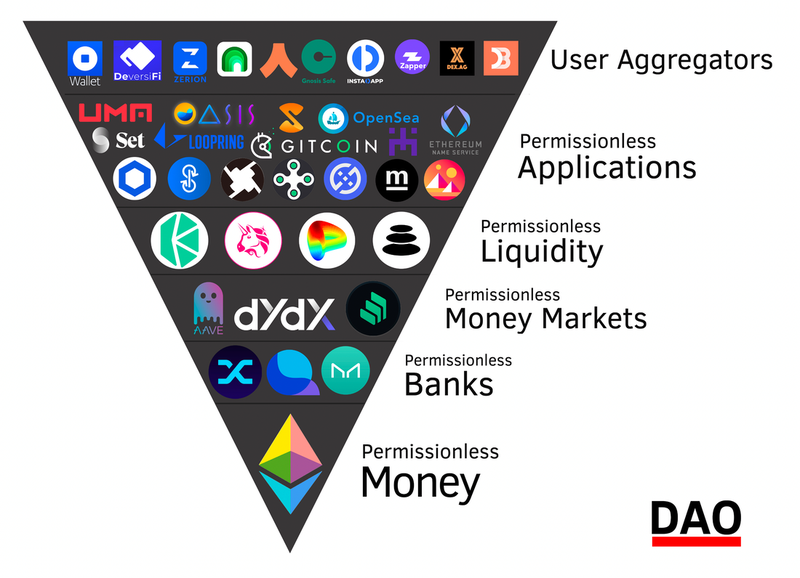
h/t junglerush.eth for the much improved graphic
Every asset is different, and each one captures these positive externalities of DeFi’s competition in varying amounts. The measure of how well different assets on Ethereum are capable of capturing these capital efficiency tailwinds is likely
Ethereum is so many things at once, all of which feed off of each other. Ethereum, the blockchain, is a world computer, the backbone of a decentralized internet (web3), and the settlement layer for web3. Its cryptocurrency Ether, is a bunch of things, too such as internet money, ownership of the ethereum network, yield-generating asset, a store of value (SoV) and a bet on more on-chain activity, or the web3 future.
4. Eth adoption has gone mainstream with strong demand drivers and network effects
In the world of crypto, Bitcoin is king. But in the years since Ethereum's 2015 arrival, the second-biggest cryptocurrency has been gaining ground via innovations (from DeFi to NFTs) made possible by its smart-contract compatible blockchain — leading fans to claim that ETH could one day overtake BTC in market capitalization. In crypto slang, this is an event known as the flippening. Now, some major analysts are making similar predictions. Is it really a possibility?4
- Ether "looks like the cryptocurrency with the highest real use potential," argues a new Goldman Sachs analysis, which predicts that ETH’s value could eventually overtake BTC’s. Ethereum’s advantages include the ability to run applications like DeFi protocols. (Goldman also predicted that England would win the Euro 2020 final, so maybe take this with a grain of salt.)
- Mad Money’s Jim Cramer is also betting on ETH. "I think [Ethereum’s] just got a little more game… Because when you go buy an NFT or anything like that, everybody wants it in Ethereum."
- ETH proponents are watching a major upgrade planned for this summer, which they believe will have an impact on prices. Among other changes, the upgrade (called EIP-1559) is designed to reduce the supply of new ETH over time — assuming demand remains constant, prices should rise.
- As of Aug 1 2021, ETH’s market cap ($310 billion) is more than 40% of BTC’s ($775 billion). But ETH has often surpassed BTC by other key metrics. In June, the number of active addresses using Ethereum briefly surpassed Bitcoin. The daily value of Ethereum transactions also regularly exceeds Bitcoin’s. On July 7, for example, ETH settled $9.4 billion worth of transactions compared to BTC’s $6.7 billion.
Why it matters… Of course, many observers remain skeptical. Bitcoin is more valuable and has been adopted as a gold-like store of wealth by a range of corporate treasuries and Wall Street funds. But popular use cases for Ethereum’s flexible blockchain continue to bubble up (how many people were talking about NFTs a year ago?) — and with emerging technologies anything is possible. Regardless, there’s plenty of room for both ETH and BTC to grow.
Another indicator of rising mainstream engagement? Reddit message boards dedicated to Ethereum (as well as crypto generally), have seen a surge in new subscribers in recent days:
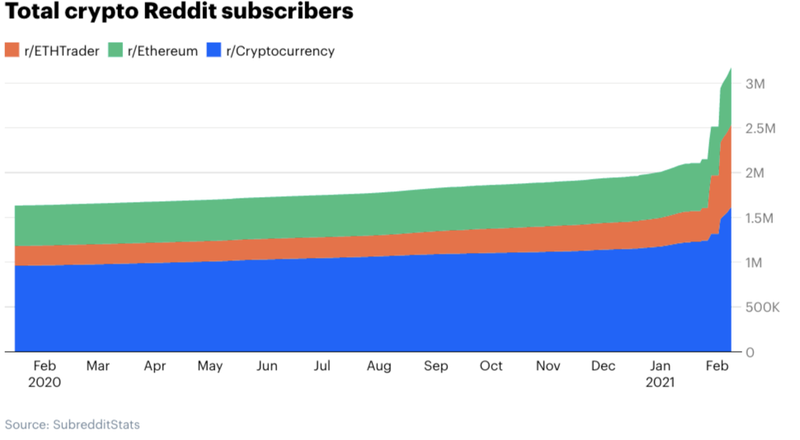
Institutional adoption of Ethereum: In large part due to stablecoins’ popularity as a non-volatile method of sending value between exchanges and DeFi protocols, the Ethereum blockchain has become one of the most popular vehicles for U.S. dollar payments. The Grayscale Ethereum Trust (which allows investors to gain Ethereum exposure via traditional brokerages) has grown substantially over the past year. The fund now holds 3 million ETH at a value greater than $4 billion.
Use Case Explosion. DeFi, NFTs, and DAOs have emerged as real use cases for crypto, and have grown spectacularly over the past year.
We are already seeing dozens of strong teams leaving traditional startups each week to build DeFi, NFTs, DAO & web3 products, many on top of Ethereum. More products and better experiences will attract more users. ETH is an indexed bet on that growth more than a bet on the success of any one project.
Strong trends, lower prices, better experiences, and new products = growing demand.
As these use cases continues to explode, Ethereum’s network effects are too strong to overcome as developers, users, and even other L1s are building on or compatible with Ethereum. The longer something has been around, the more people can expect that other people will continue to use it. Network Effects. As people recognize the quality of a thing and as it lasts longer, more people use it, so more people build on top of it. That creates a Two-Sided Platform Network Effect. More users attract more developers, more developers attract more users, and so on.
In Ethereum’s case, more dApps on Ethereum means more users on Ethereum, and more users mean it makes sense for more developers to build dApps.
OS is an example of Two-Sided Platform Network Effects. The more people who have iPhones, the more likely developers are to make iPhone apps, and the more iPhone apps there are, the more likely someone is to buy an iPhone. In Apple’s case, this network effect is so strong that it takes a 30% cut of all App Store revenues -- whether through the purchase of an app, or through in-app purchases.
Collectively, the Ethereum economy’s market cap — defined by the total market cap of the biggest ERC-20 tokens issued on top of the Ethereum blockchain — has soared in recent weeks to more than $300 billion (not including NFTs, because it’s hard to make apples-to-apples comparisons).
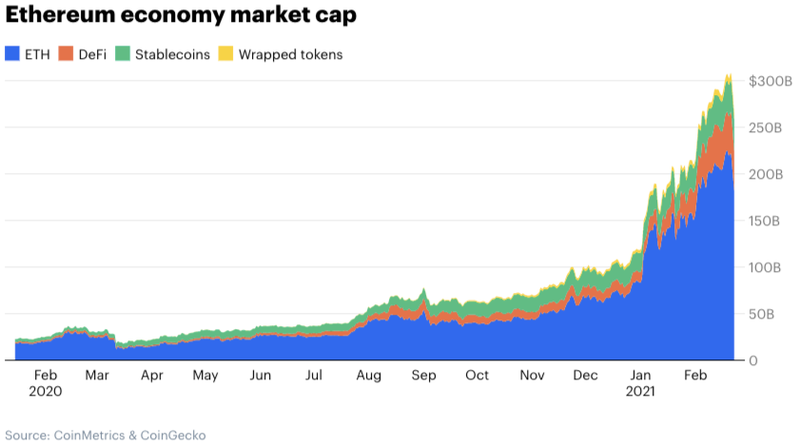
5. Ethereum holders will start accruing a lot more value
How does more activity on top of Ethereum translate into a higher price for ETH?
In the near future, the answer will be that more transactions mean higher yields for ETH holders and a decreasing supply of ETH.
Currently, the price of Ethereum is based on a combination of supply and demand, and the price it costs miners to secure the blockchain. To participate, you need ETH, and you need to pay the gas. Miners receive ETH in the form of newly-minted supply and your fees. Miners pay for hardware and electricity and taxes, and keep ~5% of their earnings. Today, most of the value accrues to GPU makers, electric utilities, and the government, with the miner’s portion competed down to close to 0. - Packy McCormick from Not Boring
- It’s Slow. The Ethereum blockchain currently does somewhere around 19 transactions per second. Visa, for comparison, does about 1,700.
- It’s Expensive. The simplest transaction costs about $5 in gas fees
- It’s Volatile. Gas fees are based on auction, and change all of the time based on demand. That makes it hard to transact with confidence or predictability.
- It’s Inflationary. Unlike Bitcoin, there’s no hard cap on the number of ETH that could theoretically be minted, and Proof of Work requires minting a bunch of new ETH, which means growth leads to dilution for existing ETH holders.
- It’s Environmentally Unfriendly. Mining means using a lot of electricity.
- It’s Inefficient. Most of the money spent on transaction fees leaves the system -- miners are forced to sell the ETH they earn to pay for electricity, hardware, and taxes.
Once EIP-1559 is implemented and the Eth2 merge is complete, value accrues to the people who hold ETH, in a few ways:
- Tips and Issuance. Tips and new issuance go to ETH holders and are retained in the system (net of taxes) instead of going to miners to pay for hardware and electricity.
- Burned Gas. Burned gas permanently removes supply from the ecosystem, and at certain transaction rates, actually decreases the overall supply of ETH each year.
This week on August 04, we're going to have an upgrade called EIP 1559, which is going to take these transaction fees and destroy them. A good analogy here is actually oil, like gasoline, there's a fixed amount of gasoline in the world. It doesn't grow very fast. You need millions of years or whatever it takes to produce gasoline. The total amount of gasoline is just keeping on reducing, reducing, reducing. There's a similar effect with Ethereum where the total amount of ETH will basically deflate. It will reduce over time because of this burning aspect.
Taken together, EIP 1559 (make ETH deflationary by changes how gas fees work by splitting them into two parts -- a base fee and a tip) and Eth2 (shift consensus from Proof of Work to Proof of Stake and introduce sharding) could be revolutionary for ETH holders because they improve performance while dramatically altering where value accrues in the Ethereum ecosystem.
There are a lot of ways to earn money on your ETH -- staking, yield farming, liquidity pools, validating, and more -- but let’s look at the simplest, just owning ETH like you’d own a stock. Lower Supply EIP 1559 means that ETH becomes deflationary. With Eth2, new issuance to reward validators is expected to drop dramatically versus Proof of Work rewards. With EIP 1559, by burning ETH in every transaction, assuming a conservative amount of daily transaction fees and that 70% of the gas fee is burnt and 30% is sent as a tip, then more ETH will be burnt than issued every day. Together, the supply of ETH will actually begin decreasing after EIP 1559 and the Eth2 merge. With the upcoming implementation of EIP 1559, Ethereum will likely become deflationary, knocking out its biggest monetary weakness.
ETH ownership also grants the right to do work for the Ethereum network as a validator and earn a share of fees. Another Drake model estimates that people who stake their ETH (meaning lock it up to secure the network) can earn a 25% APR including new issuance and tips.
Ethereum 2.0 isn’t just a scalability upgrade to the Ethereum network, but it’s also an economic upgrade to Ether—the money that powers and protects the Ethereum economy
The combination of Proof of Stake, a consensus mechanism that minimizes the need to issue ETH, and EIP1559, a mechanism that burns ETH as a function of the magnitude of the Ethereum economy, turns ETH into a monetary unit with what can only be described as having ‘Sci-Fi’ economic fundamentals behind the currency unit.
Additionally, the more ETH is worth, the harder it is to attack.
In Ether: A New Model for Money, Hoffman said that fees paid to Ethereum validators act as a wall that protects Ethereum: “The height of the wall is highly correlated with the total fees produced by the network. The height of the wall is the cost of attacking Ethereum.”
6. Eth may emerge as world’s most efficient triple-point asset
A 1997 Journal of Portfolio Management paper by Robert Greer, What is an Asset Class Anyway?, says that there are three asset superclasses:
- Capital Assets are productive and generate value or cash-flow. Examples include equities, bonds, or rentable real estate.
- Transformable/Consumable Assets can be consumed one time, transformed into another asset, and their consumption produces economic yield. Think energy or commodities.
- Store-of-Value Assets are scarce, cannot be consumed, just transferred, and their value persists over time and space. Examples include gold, currencies, art, or bitcoin.
These three phases can occur simultaneously with Ether:
- Store of Value. ETH is locked up as collateral for DeFi transactions. For example, you can put up ETH to secure a loan or to provide liquidity to a DEX. Currently, nearly 10 million ETH are locked in DeFi.
- Consumable Asset. With EIP 1559, gas fees will act like gasoline in a car. Any time something happens on Ethereum, gas needs to be burned, decreasing the overall supply.
- Capital Asset. Ether acts as a capital asset in a few ways. Owning ETH represents a share of the Ethereum network, like owning equity in a company. Once staked, ETH gives its owner the right to do work for the network by becoming a Validator and a right to collect fees generated by the network.
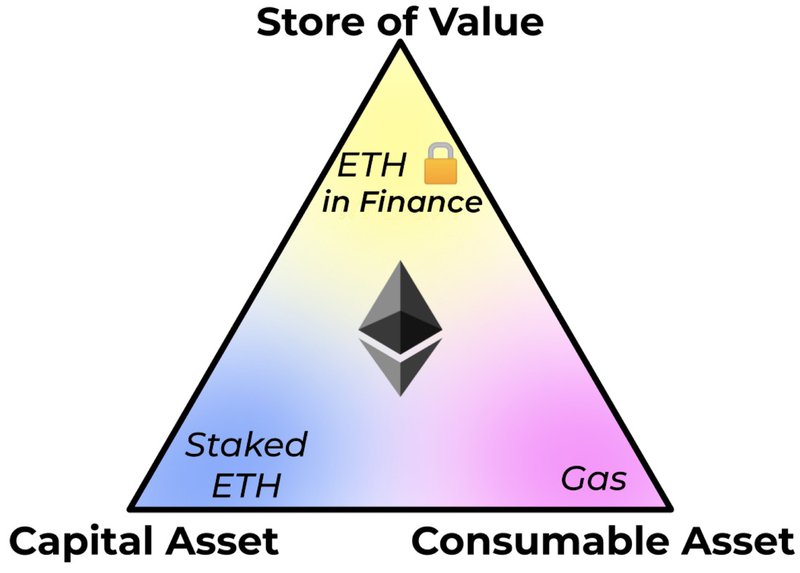
DeFi is on an unstoppable march with its eyes are on capital efficiency, and Ether is the best asset available for DeFi to achieve its goals.
While the Ethereum protocol is busy turning ETH into ultra sound money, Ethereum’s application layer is simultaneously trying to make it the most capital efficient asset in the world.
When you can achieve the same financial results with less capital, capital will flow into the asset that enabled the capital efficiency. If it takes $10 USD to achieve the same outcome that $1 of ETH can provide, it is simply smart capital management to purchase and hold the asset that allows you to achieve your goals with the least amount of capital. The optionality that ETH can offer you will be overwhelming from a capital efficiency standpoint.
Over time, the path towards achieving specific financial goals will be increasingly routed through using ETH as capital. At this point, ETH will become the internet’s reserve currency, and its economic bandwidth will be massive.
DeFi is turning ETH into the best Store of Value inside of its internal ecosystem. If ‘DeFi’ ever just becomes ‘Fi’, then ETH will therefore also become the world’s best Store of Value.
Every new DeFi protocol that finds success, finds it because it was more capital efficient than its competition. Every protocol upgrade that any DeFi application has gone through has been in an effort to become more capital efficient. In DeFi, capital efficiency is the name of the game.
Ether, as the native asset to Ethereum, and therefore DeFi, is the asset that receives all of the tailwinds of this competition. When DeFi becomes more capital efficient, Ether becomes a more efficient asset.
DeFi is on a march towards capital efficiency, and ETH will receive all of it.
7. ETH will be the dominant Layer 1 solution
A handful of blockchains/L1s are aiming to thrive where Ethereum is weak. Ethereum, Bitcoin, and other blockchains are Layer 1 in the Web3 tech stack. For Bitcoin, pretty much everything, aside from Lightning Network, happens at Layer 1. Hold BTC, send BTC, track BTC. For Ethereum, most of the magic comes in the interaction with Layer 2, the application layer.
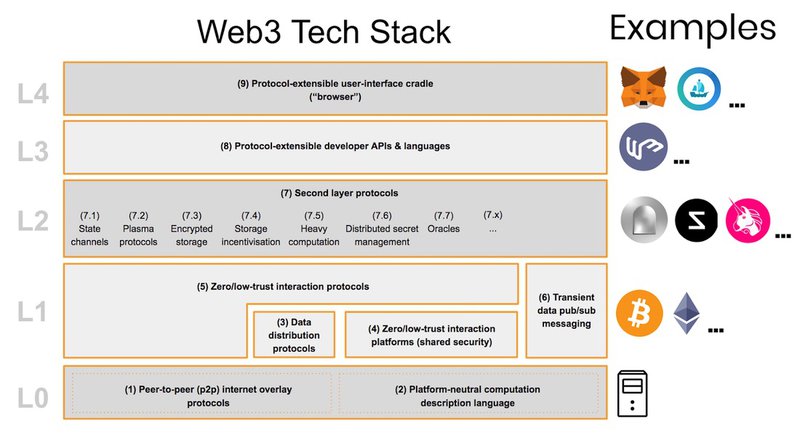
Source: readthedocs.io, NotBoring.co
Because of Ethereum’s current shortcomings to date, a handful of L1 competitors have sprung up that seek to challenge Ethereum’s dominance, or at least pick off some of its use cases.
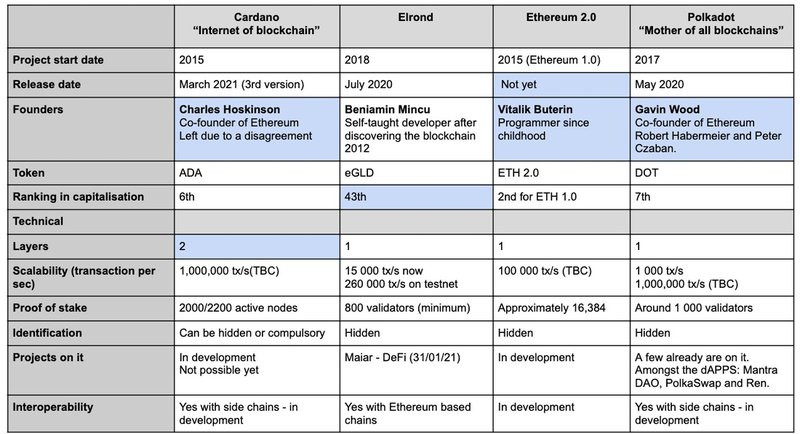
The reality is that most of the competitors are either in development (like Cardano, so your conviction levels have to be much higher) or are inter-operable with Ethereum (e.g. Polkadot). Solana and Flow are actually also, in some ways, a complement to Eth.
By optimizing for a high-speed trading use case not currently possible on Ethereum, Solana is bringing more financial activity on-chain. By enabling micro-transactions like votes and likes, on-chain, and improving the user experience for products that also run on Ethereum, Solana is improving the web3 experience and onboarding more users. Plus, Solana is building compatibility with Ethereum that would allow it to behave like an Ethereum L2, but with the functionality of a L1, including the ability to deposit USD directly at miniscule fees. More on-ramps is net positive for the ecosystem as a whole, and Ethereum sits at the center of the ecosystem. As Flow brings more non-crypto people into Web3, both Flow and Ethereum benefit. Given the nature of web3 and how early the ecosystem is, more complements bringing more demand is a positive.
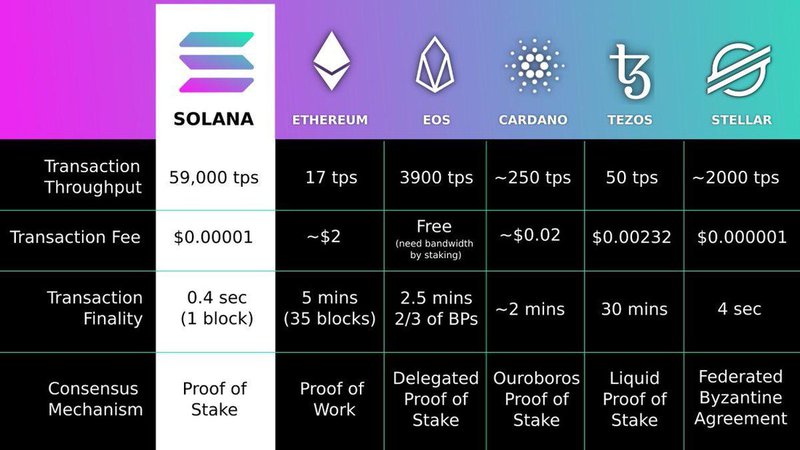
But what about competition from more centralized solutions like Binance Smart Chain, which comes with a built-in user base of millions of people who trade on Binance, are decentralized enough and more performant? Binance Smart Chain shows the total value locked in its DeFi smart contracts at $34.7bn, 60% of Ethereum’s figure, with a growth of 152% in the 30 days between mid March and mid April 2021.
Binance Smart Chain is not decentralised by its own admission, which can have its own risks highlighted here. But there are signs that projects will just go where the users are and the fees are lowest.
Closing thoughts
Ethereum isn’t just another form of digital money. Ethereum’s blockchain was created to be a highly versatile decentralized computing platform — one which allows developers to build things like markets for digital art and which also runs “decentralized finance” (or DeFi) tools like Compound and Uniswap that have seen hundreds of billions of dollars in value flow through them.
If you believe that Web 3.0 will continue to grow, then EIP 1559 and Eth2 upgrades can level up Eth as a triple-point asset class and solidify its position as the main L1 for web 3.0. Strong network effects will create a flywheel effect among developers, users and other L1/L2s in the system to increase adoption and inter-operability of Eth.
For investors, I'd say learn, learn, learn. People always ask me, "Should I invest in Ethereum?" I tell them," just don't invest in anything until you know what you're talking about". The market is so extremely volatile. You'll follow in on the way up and then you'll panic sell on the way down. Really what you want to be having is long-term conviction, and the only way that you can have long-term conviction is basically understanding this stuff. One word of caution here is that if you're intellectually curious and you go down this route, you're never going out of the rabbit hole. This rabbit hole is extremely, extremely deep. You might spend 10 years of your life going down the rabbit hole, and whenever there's something you don't understand, don't be shy to ask questions. There's a lot of information out there.
Curious about the diving deeper and understanding more about Ethereum? Do read the white-paper here!
This is not investment advice. Bitcoin and Ethereum are highly volatile. Only invest what you can afford to lose. You must decide how much of your investment capital you are willing to risk with Ethereum or Bitcoin. No warranties are expressed or implied.
1 https://www.notboring.co/p/own-the-internet
2 https://www.joincolossus.com/episodes/14242194/drake-ethereum-into-the-ether?tab=transcript
3 https://newsletter.banklesshq.com/
4 https://www.coinbase.com/learn/market-updates/deep-dive-ethereum-economy
This article was originally published here.
